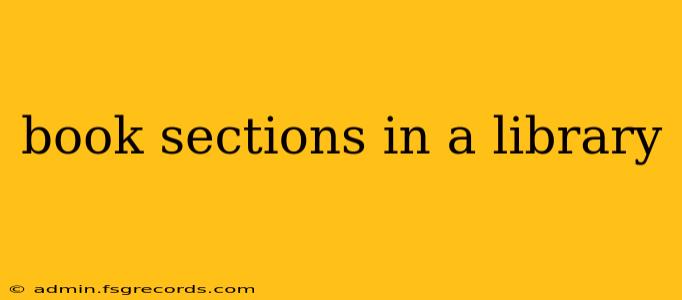Finding a specific book in a vast library can feel like searching for a needle in a haystack. But understanding the organizational system used – typically the Dewey Decimal Classification (DDC) – can transform your library experience. This guide breaks down the key sections of a library, helping you navigate with confidence and efficiency.
Understanding the Dewey Decimal System
The Dewey Decimal System is a library classification system that organizes books and other library materials by subject. It uses a hierarchical structure, assigning a unique number to each subject. These numbers are arranged in increasing order, allowing for a logical and intuitive arrangement on library shelves. The system is broken down into ten main classes, each further subdivided into more specific categories.
The Ten Main Classes of the Dewey Decimal System: A Deep Dive
While the specifics can vary slightly between libraries, the ten main classes generally represent the following:
000 Computer science, information, and general works: This section covers computer programming, library science, encyclopedias, and general reference materials. You'll find dictionaries, thesauruses, and guides to research methodologies here.
100 Philosophy and psychology: Explore the big questions of life, human nature, and the mind. This section includes works on ethics, logic, metaphysics, and various schools of psychological thought.
200 Religion: This expansive section encompasses various religions and spiritual traditions worldwide, including their histories, doctrines, and practices.
300 Social sciences: This broad category covers sociology, economics, political science, law, education, and more. You can find books on social issues, government policies, and educational theories within these shelves.
400 Language: This section focuses on linguistics, grammar, dictionaries, and language learning resources. It includes books on the structure and evolution of languages.
500 Pure science: Here you'll find works on mathematics, physics, chemistry, astronomy, biology, and other scientific disciplines. This section often includes textbooks and scientific research papers.
600 Technology: This section covers applied sciences and technologies, encompassing engineering, medicine, agriculture, and various technical fields. Expect to find practical guides and technical manuals here.
700 Arts and recreation: This is a popular section encompassing visual arts, performing arts, sports, hobbies, and recreation. This is where you will discover books on painting, music, theatre, photography, and various forms of entertainment.
800 Literature: This section is dedicated to literary works, including poetry, drama, fiction, and essays. It's organized by language and often chronologically or alphabetically by author.
900 Geography and history: This section covers the world's geography, history, and biographies. You'll find detailed maps, historical accounts, and biographical studies of prominent figures.
Beyond the Main Classes: Finding Your Book Efficiently
Each of these main classes is further subdivided into more specific categories using decimal points. For example, 500 Pure Science might be broken down into 530 Physics, 540 Chemistry, and so on. These subdivisions continue to narrow down the subject matter, allowing for a very precise organization.
Many libraries also use additional systems for organizing materials like call numbers, which combine the DDC classification with other identifiers to uniquely locate each item.
Mastering Library Navigation: Tips and Tricks
- Consult the library's floor plan: Most libraries provide detailed floor plans that show the location of each section.
- Ask a librarian: Librarians are invaluable resources; don't hesitate to ask for help finding specific books or sections.
- Familiarize yourself with the online catalog: Most libraries have online catalogs that allow you to search for books by title, author, subject, or keyword. This can often provide the specific call number to help you locate the book directly on the shelf.
By understanding the structure of the Dewey Decimal System and utilizing library resources, you can unlock the vast potential of any library, making research, discovery, and reading a more efficient and enjoyable experience.

